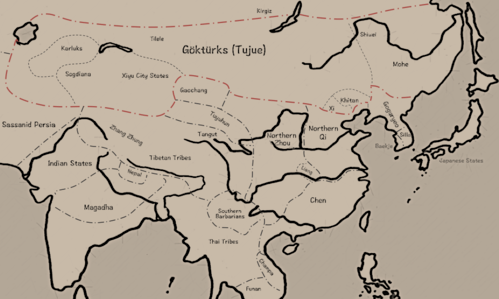Muqan Qaghan
| Muqan Qaghan 木桿可汗 Ashina Yandou 阿史那俟斤 | |
|---|---|
| Third Qaghan of the Turkic Khaganate | |
| Reign | 553 – 572 |
| Predecessor | Issik Qaghan |
| Successor | Taspar Qaghan |
| Died | 572 |
| Issue |
Apa Qaghan Empress Ashina Yangsu Tegin |
| House | Ashina |
| Father | Bumin Qaghan |
Muqan Qaghan;[1] (Old Turkic: 𐰢𐰆𐰴𐰣𐰴𐰍𐰣 Muqan qaγan,[2] Chinese:木桿可汗/木杆可汗, Pinyin: mùgǎn kěhàn, Wade-Giles: mu-kan k'o-han or 木汗可汗, mùhàn kěhàn, mu-han k'o-han, personal name: 阿史那燕都, āshǐnà yàndōu, a-shih-na yen-to) was the second son of Bumin Qaghan and the third khagan of the Göktürks who expanded their khaganate and secured the borders against the Hephthalites.
Reign
His accession to power was followed by finishing off remnants of Rouran. Around the new year 554, after defeat of Yujiulü Kangdi at the hands of Tujue, the remnants of Rouran, which by that point was near its end, surrendered to Northern Qi to seek protection from Tujue attacks. Emperor Wenxuan personally attacked Muqan Qaghan, fighting his army off and then created Yujiulü Anluochen as the new khagan of Rouran, settling the Rouran people within Northern Qi territory, at Mayi (馬邑, in modern Shuozhou, Shanxi).
Eventually last khagan of Rouran Yujiulü Dengshuzi was executed by Emperor Gong because of Tujue pressure.[3]
In fall 563, Northern Zhou entered into an alliance treaty with Tujue against Northern Qi, part of which involved a promise that Emperor Wu would marry the daughter of Muqan Khan. In winter 563, the joint forces of Northern Zhou and Tujue launched a two-prong attack on Northern Qi, with the northern prong attacking Northern Qi's secondary capital Jinyang (晉陽, in modern Taiyuan, Shanxi) and the southern prong attacking Pingyang (平陽, in modern Linfen, Shanxi).
In spring 565, Emperor Wu sent his brother Yuwen Chun (宇文純), Yuwen Gui (宇文貴), Dou Yi (竇毅) and Yang Jian (楊薦) to lead a ceremonial guard corps to Tujue to welcome back Muqan's daughter for marriage to him. However, when they arrived at khagan's headquarters, he turned against the treaty and detained Yuwen Chun and his attendants.
In spring 568, a major storm at Tujue's headquarters inflicted substantial damage, and Muqan khagan took it as a sign of divine displeasure at his rescission of the marriage agreement with Northern Zhou. He therefore returned Yuwen Chun, along with the daughter he promised Emperor Wu, back to Northern Zhou. Emperor Wu personally welcomed her and created her empress.
Campaigns in West
His uncle Istämi autonomously ruled the far-west region in his name. Turkic army destroyed Hephtalite power in 557 near Bukhara.[4] Northern part of the Oxus river annexed to the Göktürks and southern part to Sassanid Persia.
Legacy

This expansion also pushed against the Avars who were driven toward the Byzantine Empire and the Sassanid Empire and eventually toward the Danube. Other tribes of the Central Asia, such as the eastern Bulgars were also displaced.[5]
Muhan's reign marked the pinnacle of Sogdian cultural influence in the Göktürk Empire. Sogdian culture was transmitted by merchants from Turpan who worked as ambassadors and advisers. The Sogdian language and script were used to govern the empire.[6] The importance of Sogdians cannot be understated in keeping the early Turks safely outside of the Chinese cultural sphere. The Sogdian language and script were used to administer the empire, because it was the only written language in the cities under his control.
He expanded the Göktürk Khanate and secured the borders against the last of the Rouran people. He conquered the Töles tribes in the west, the Kitans in the east and the Kyrgyz in the north. Thus he expanded his state to all the former Xiongnu territory.
After Muqan's death in 572 the title of khagan passed to his younger brother Taspar.
Appearance
According to Zhou Shu, he had wide face and red hair with lapis eyecolour.
Family
His daughter Empress Ashina was the wife of Emperor Wu of Northern Zhou. His son Apa Qaghan claimed the throne after death of his uncle Taspar unsuccessfully while his other son Yangsu Tegin was ancestor of later Western Turkic Qaghans.
References
- ↑ Gary Seaman, Daniel Marksm, Rulers from the steppe: state formation on the Eurasian periphery, Ethnographics Press, Center for Visual Anthropology, University of Southern California, 1991, ISBN 978-1-878986-01-6, pp. 96–97.
- ↑ Ethno Cultural Dictionary, TÜRIK BITIG
- ↑ "邓叔子", 维基百科,自由的百科全书 (in Chinese), 2016-03-08, retrieved 2018-07-26
- ↑ "ḴOSROW II – Encyclopaedia Iranica". www.iranicaonline.org. Retrieved 2018-07-26.
- ↑ Bauer, Susan Wise (2010). The History of the Medieval World: From the Conversion of Constantine to the First Crusade. W. W. Norton & Company. pp. 238–241. ISBN 978-0-393-05975-5.
- ↑ Roux 2000, p. 79.
Sources
- Roux, Jean-Paul (2000). Histoire des Turcs (in French). Fayard.
Muqan Qaghan | ||
| Preceded by Issik Qaghan |
Khagan of the Turkic Khaganate 554–572 |
Succeeded by Taspar Qaghan |